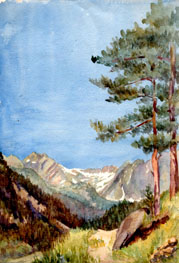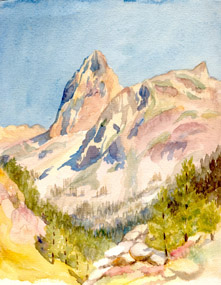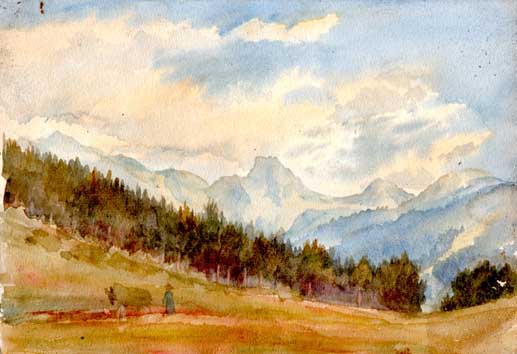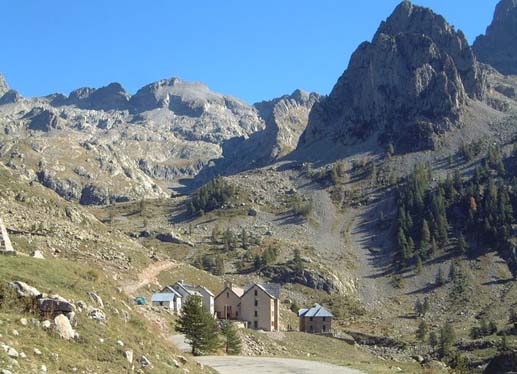I want to write about the summer of 1921, when we made a longer visit to Aunt Nell and all — including Amelie and the cook — spent the hot weather at a house let to visitors. Aunt Nell had taken this villa, in the mountain town of St. Martin Vesubie, in the Alpes Maritimes, where the road from the coast ended. The town itself was interesting – its main street was long and steep with an ever-running, narrow stream of water. Its houses were complicated collections of stairs, ladders and landings, and at the top were the villas let in the summer.
The three girls and I had long walks, but Aunt Nell thought it bad for them to do real hard walking or long expeditions. She was 100 years out of time's modern ways. I used to get up at 5 o'clock, have a hurried walk in search of wild flowers, and be back for 8 o'clock breakfast. One day, we were walking past a field near the village, and I called to the girls "Look, the field is on fire!" The scarlet and orange large lilies, moved by the wind, really were flame-like.
The next effort to give the girls something to do and to keep them from being bored was the idea of acting a little play in the garden. As soon as I found out that no one of the three was inclined to learn any part but that they were all willing to dress up and remember something of the movements, I changed it to be done in dumb show. Nelly, in my pink silk dressing gown, as the Lady. Mariamne, in Uncle Serge's best pyjamas, as Harlequin (with whom Nelly ran away eventually). Iya, in a silk evening cloak, as Disappointed and Quarrelsome Hopefuls. The two Schmitz girls, very nice friends from Nice, and their Dame de Compagnie, Mme Magnoli (and, of course, Aunt Nell and Mother), were audience, and I think the girls enjoyed it. The garden made an excellent scene, with a corner of the house walls and paved ways of the garden. At least, it kept them with something to do for several weeks.
Our unexpected real little drama developed out of a day's expedition with the Schmitz girls and Mme Magnoli. Our walk was the six miles up to the church of the Madone, which was a shrine below what was called Caïre de la Madone, a name for a peculiar slit in the peak above – a curious hole in the Monte, in which the Virgin was supposed to appear. We went up the rough path on the north track and had a very substantial lunch. The Schmitz girls then persuaded Mme Magnoli to take the south side of the stream to return. This was a bad mistake. The path on the opposite side to the road proved to be unused, after a storm had brought down a whole tree and made the path a very hard, almost impassable, track.
It was a steeplechase all the way, and Mme Magnoli soon collapsed on the ground, said she was dying, and refused to budge. There was a hope of help, when a man appeared on the road, got up in a climber's turn-out and followed by a man with a luggage-bearing mule. But both men were disagreeably unkind and refused even our plea that they would send help from the hotel near the church.
Soon after, real kindness and help arrived. A small party of Italian soldiers, part of the guard who were always about when the King of Italy was chamois hunting (the frontier was thereabouts), met us on the path. One of the soldiers had made friends with us on our walks, a pleasant young fellow. When we explained our trouble, he immediately came over the river and carried Mme Magnoli across to the well-known north side. He told us he would have carried her all the way down to St. Martin, but they were on duty.
After some discussion, the poor lady was deposited on the wide slab of rock in front of the Police hut used by the Douaniers for the fight against smuggling. I covered her with all the coats and, being quite convinced that her illness was only the result of too much exertion after too much lunch, sent the five girls down with the soldiers and stayed with the poor Dame de Compagnie. The Schmitz girls were a sufficient safeguard of manners.
Actually, I enjoyed the wait. It was most interesting to see that, contrary to the usual, darkness was not falling; it was coming up from the drop of the river, and the air was peaceful. After I don't know how long, with Mme still quiet, the rescue party appeared, with the Doctor, the mule and muleteer. Mme was woken up from a good sleep and helped to the saddle, as my diagnosis had been confirmed, and we had a pleasant and comfortable walk back to town.
One result of this was meeting Mme Magnoli on the Promenade, being folded in her arms and proclaimed the saver of her life – all this in the middle of the usual crowd of promenaders.
 A more happy result was that the doctor (a mountaineer in a mild way), his wife and a young Club Alpin expert invited me to climb the only real mountain in the neighborhood, a peak called Gelas. We set off very early in the morning for what could hardly be called a climb (actually a long walk) and reached the narrow line of the summit with no difficulty. From that rocky ending, half of the great Alps were named to me in the distance.
A more happy result was that the doctor (a mountaineer in a mild way), his wife and a young Club Alpin expert invited me to climb the only real mountain in the neighborhood, a peak called Gelas. We set off very early in the morning for what could hardly be called a climb (actually a long walk) and reached the narrow line of the summit with no difficulty. From that rocky ending, half of the great Alps were named to me in the distance.
Coming down from the Gelas, I had to get help from the Club Alpin, once for the placing of my feet in a dark chimney which had to be negotiated. When we arrived at the foot, both the Doctor's wife and I were so tired that I was reduced to tears. We both were full of satisfaction, however, when we got into the Hotel. After a cheerful dinner and a good night at the Hotel, I left early to walk back to St. Martin, not by the road, but across the hills with no paths.
It was a glorious walk, being a fine day, and the way was lovely. The soldiers passed me on a lower way, in the opposite direction (to report for guard duty), with merry, cheerful farewells. My chosen line stopped abruptly when it brought me to the edge of a straight drop of, perhaps, 150 feet. From this great height, I looked down on a little blue jewel of a lake called Lago de Tre Colpas (Lake of the Three Sins), far below, and there were several chamois by the lake and, beyond, more falling miles. I watched them for some time, while I made a hurried watercolour sketch, with a feel to attempt to put on paper the exquisite tint of unnameable blue. After I had enjoyed the sight of the chamois, I shouted loudly, and the little group vanished, in a blink of the eye, up the cliff to the right.
 I began to climb down the rough fall of the line and sat by the little lakeshore to eat sandwiches. On the opposite side of the lake was another steep fall of land, now covered with green grass as pleasant to walk on as a well-kept lawn. Among the trees (large firs), scattered lavishly on the green, were wild pansies of every shade from purple to white, and all flowering as if it was their pleasure as well as their nature -- a heavenly carpet. The slope brought me to the source of the river Boreon -- across the top of a wall of rock was a lake of ice, slowly thawing to a dripping and then a fall of water, which became a stream.
I began to climb down the rough fall of the line and sat by the little lakeshore to eat sandwiches. On the opposite side of the lake was another steep fall of land, now covered with green grass as pleasant to walk on as a well-kept lawn. Among the trees (large firs), scattered lavishly on the green, were wild pansies of every shade from purple to white, and all flowering as if it was their pleasure as well as their nature -- a heavenly carpet. The slope brought me to the source of the river Boreon -- across the top of a wall of rock was a lake of ice, slowly thawing to a dripping and then a fall of water, which became a stream.
As I found that I had come the right way, to the river which ran into St. Martin, I had nothing then but to follow the stream to get to our villa. Along the way, by the very rough banks – rocky and full of long-fallen trees and branches – I had a good look for flowers. A wild clematis was the pleasant result. The next stop was at a small platform of grass above a rocky fall of the River and the four or five little plants that turned it into "Paradises Fenestres" – orchids and blues and lesser beauties which perfected the whole. Mountain flowers were in such abundance and so neglected that new and rich finds did not fail. I got home in good time, after the best walk of my life.
We all returned to Nice at the end of the summer, and Mother and I went home.
AUNT NELL
Eleanor Hester Mary Pringle, London-born daughter of Lt-Colonel John Henry Pringle & Georgiana Ramsbottom, wife of Uncle Serge, and sister of EV's mother.
VILLA
After 1917, when the Plaoutines had their money and properties stolen by the Bolsheviks, Aunt Nell and Uncle Serge were unable to spend the summers at their usual place in Royat. Ronald Lindsay, Aunt Nell's cousin's son, came to the rescue and supplied them with the means to live comfortably for the rest of their lives in Nice. This leased villa in St. Martin Vesubie, suited their means and became the summer retreat, until the death of Aunt Nell in 1924. After that, Ronald continued to support Uncle Serge, until his death in 1926.
THE THREE GIRLS
Elena "Nelly" Denissieff, Iya Denissieff, and Mariamne Denissieff, three daughters of Sergei Fedorovich Denissieff and Vera Sergeyevna Plaoutine (Vera being cousin to EV). At the beginning of the Russian Revolution, the girls were removed from harm's way and sent to live with their Plaoutine grandparents in Nice.
UNCLE SERGE
Aunt Nell's Russian-born husband, General Sergei Nikolaevich Plaoutine, son of General Nikolai Fedorovich Plaoutine & Severin Iosifovna Kalinowski.
A LITTLE PLAY
It is obvious by the character's names that it was a little play which EV had crafted by using bits of the "Commedia d'ell Arte".
TWO SCHMITZ GIRLS
Paule-Andree Schmitz and Rolande Schmitz, whose father owned the "Hotel Westminster" in the Alpes-Maritimes (near Menton).
DAME DE COMPAGNIE
Mademoiselle Magnoli, companion of the Schmitz sisters.
THE CHURCH OF THE MADONE
The Shrine of Our Lady of Fenestres, a Benedictine chapel, is located in a small clearing on the side of Mount Gelas, a mountain in the Alpes Maritimes.
DOUANIERS
French Customs Agents.
CHAMOIS
A beautiful goat-antelope species, native to the European Alps.
HOME
EV and her Mother were living in their own home, Ashmead, 27 Graham Road, Ipswich, Sussex County, England.
ILLUSTRATIONS
1) Col. St. Martin Vesubie (September 1921) — watercolour by EVJ
2) The Expedition Party (1921)
Left to Right: EVJ, Mariamne, M. Magnoli,
Iya, One of the Schmitz Girls, Nelly
Two Italian Soldiers, Priest at the Chapel
3) Madone de Fenestre, St Martin Vesubie
4) Shortcut to the Boreon, St Martin Vesubie, June 1921 — watercolour by EVJ
5) Boreon Valley, August 1921 — watercolour by EVJ
Text and images may not be
used without written permission.
Click for Contact Information


